Not sure how I lost track of this post about two cotton bolls. I started writing it in the fall when my friend Robyn of Robyn’s World first flagged me about a tweet she saw from Tara Ziegmont of Feels Like Home blog. Seems Tara had a small cotton boll from a plant her family grew and wondered what had happened.
Here’s the photo and text Tara shared:
The conversation on twitter about what happened included a few thoughts about why the lint in the boll looked so hard. Was it left on the plant too long? Was there something else happening? I mentioned heat units and realized I may need more than 140 characters. Months later I’m finally writing them!
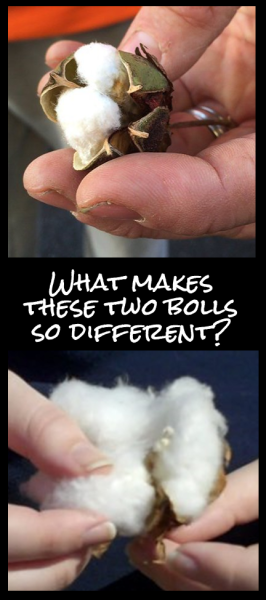 Noticing/Diagnosing the Problem
Noticing/Diagnosing the Problem
Tara said Joe had cotton in their garden — that’s a unique thing to grow in Pennsylvania! My bet is there aren’t a lot of consultants in the area and I don’t recall seeing any book on how to grow cotton in a garden since it is generally grown in larger fields. That makes troubleshooting harder than it tend to be in other crops where lots of information is available.
When Tara & Joe saw the boll, they wondered about the problems there could have been with harvest timing. When I saw the photo, I had a totally different look at it — I thought about the summer.
Comparing to Other Cotton Bolls
Tara said they had about half a dozen cotton bolls on the plant but the one in the photo was best. Having tried to grow cotton when I was in New York, I remember that feeling of success from producing a boll. I noticed it was a lot smaller than the bolls I see in cotton fields. You can see the photo she sent alongside one from a harvest time day I had.
So the boll that Tara got is a lot smaller than most cotton plants produce and if you look at it, the hard, woody parts of the boll didn’t open too well and the lint didn’t fluff out. This video from several years ago shows an agronomist comparing bolls during a rainy fall. My amateur diagnosis from afar is the boll on Tara’s plant didn’t have a chance to fully mature.
A Good Start
A long tap-root is something cotton develops, which means planting the crop in containers isn’t the best way to grow them out. Soils for cotton should be light and well-drained like silt loam. While the plants need some moisture to get started, a lot of rain on small cotton plants can cause problems. Also, to make sure plants get a good start and keep growing, they run soil samples looking for key nutrients like nitrogen, phosphorus and potassium.
How Cotton Plants Develop
While I’d love to pretend cotton is totally different from all others, it really isn’t. It is a crop that likes heat, we’ll talk about that a bit more later though. Cotton plants can keep putting flowers and bolls on for a long time because cotton is a perennial plant, we just grow it like it is an annual.
It is really important that the plant get the right nutrition, environment, etc when flowers start growing and as they continue to mature (that’s the plants reproductive cycle as this produces seeds). This video will show you the various points in the fruiting process.
What the video doesn’t show is the seed inside the lint. See, seed is what the plant really wants to produce, so it puts energy there and then from that, is where the lint comes. So let’s look at what cotton bolls need to develop well.
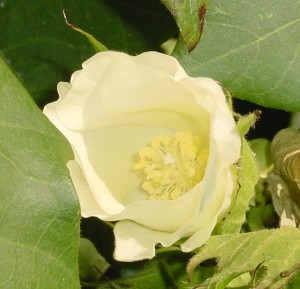 Good Pollination
Good Pollination
In the video I show the white flower, how the white flower begins to pinken up and how it became a bright pink. I have to wonder if Tara’s plant got really good pollination. Sometimes flowers don’t produce much pollen for one reason or another. Sometimes rain washes pollen away. sometimes it is so hot, the pollen doesn’t dehiss (pop open). The plant needs the pollen to get to the ovary which is at the base of the flower. You can see in the flower at left that the stamen are holding on to that pollen. Later that afternoon it should have dropped to the base of the flower.
Hot, Dry Weather
Cotton is a Southern crop in large part cause it needs lots of heat and sun. In fact, there is a way of calculating heat cotton plants need (DD60s — degree days based on 60 as a minimum).
The extension service provides the how to calculate DD60s as a mathematical equation:
((Max temp + Min temp)/2)-60
Example: A day with a high of 90 and a low of 60 would accumulate 15 DD60’s. You add up daily DD60s to determine the heat unit (DD60) accumulation for a given period of time.
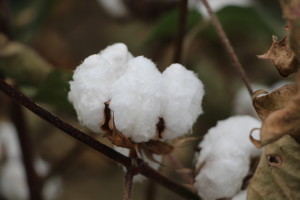 The plants need 130-160 days and 2200-2600 DD60s to produce cotton bolls. You can see where your plant is in the growth and development cycle and those all match up to the photos of what a cotton plant looks like.
The plants need 130-160 days and 2200-2600 DD60s to produce cotton bolls. You can see where your plant is in the growth and development cycle and those all match up to the photos of what a cotton plant looks like.
The seed and lint inside the boll mature and will work like Jiffy Pop popcorn in that foil package. It puts pressure on the boll walls, which begin to dry down. If you look at the video, cotton bolls go from green to a burgundy when it starts drying down then it cracks open and as it continues to dry, it will continue to open up. If everything goes perfectly, you have a bunch of bolls that look like this.
My Diagnosis
So, with all of that said, I think the photo Tara had shows a few things…. 1) that pollination may not have been complete, leaving the boll somewhat hollow, 2) the fiber in the boll didn’t have a chance to fully mature due to either nutrition or heat deficiencies. After checking with several others, there seems to be a consensus that those may have been the primary factors but of course it’s much easier to diagnose knowing more details!
Hope this Helps!
Not sure this is exactly what may help Tara & Joe figure out what happened to their cotton bolls, but hopefully it will help them this summer if they try again. If there are more questions, feel free to leave a comment so I can pull together a followup if there are enough questions.
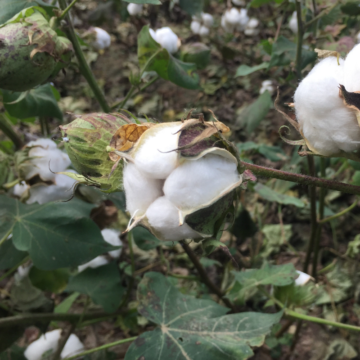
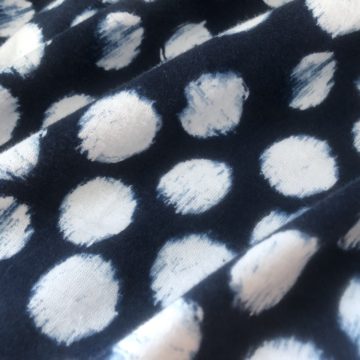



Testing.
Love the cotton pics, Janice. Always fun to see crops from other parts of the world!
Hey JP,
Wish I had found your blog sooner and done more homework. I am a home gardener who likes to try different things, so this year I grew two cotton plants. The fiber wasn’t fluffy (i forget what you called it in the video), I think it was either water, soil (tends to clay) or lack of fertilizer. It certainly isn’t DD60’s as I live in So. California. I learned a lot and will probably try again.
Very cool! You may want to make sure you have some potassium fertilizer available when the plant starts fruiting.